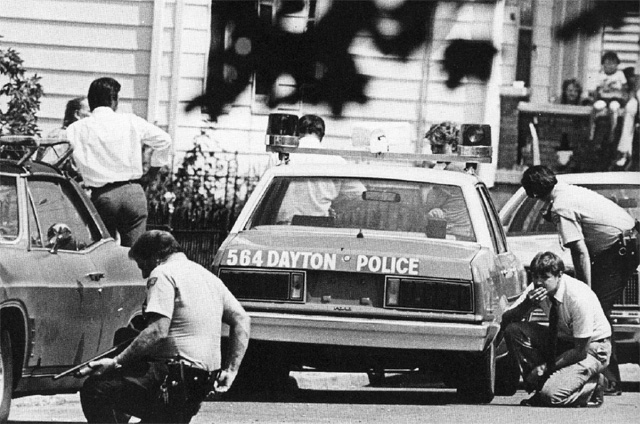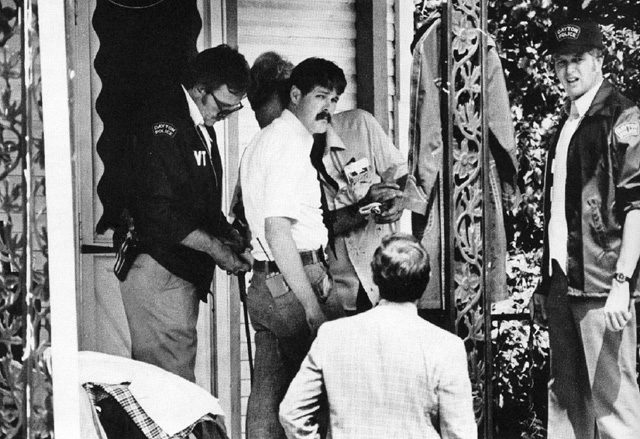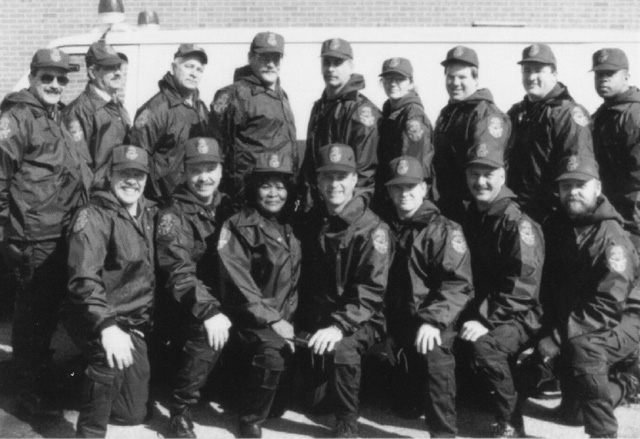The Origin of the Hostage Negotiation Team (1978)
The Dayton Police Hostage Negotiation Team (HNT) originated in concept in 1978, arising from changes in emergency response practices that were developing in several major U.S. cities in combination with a local incident that occurred on December 8, 1978 at 112 Marathon Ave. In that case, a man barricaded himself in his house, claiming he was holding two children at gunpoint and had the house booby-trapped with explosives. A detective supervisor attempted to negotiate the man outside. After a six-hour siege, gasoline exploded on the second floor of the house causing a fire and the man died from a self-inflicted gunshot wound. The police entry was slowed by the potential booby-traps and fire. No hostages were found and, although there was an arsenal of weapons, no explosives were found. This incident was the local catalyst for the formation of a trained, professional hostage negotiation team.

Dayton Police Respond to a Crisis Incident in East Dayton in 1983.
The Dayton Police Department’s first HNT commander was Lt. Daniel L. Baker. He was appointed by Chief Grover O’Connor. He was called upon to act as a police negotiator at an incident in 1979 and to create a team of police negotiators by the start of 1980. Lt. Baker recounted that “the old days of ‘surround ‘em, gas ‘em and get ‘em’ gave way to an integrated approach that prevented injuries and death to police and citizens.”
Although Lt. Baker does not take credit as the ‘first negotiator’, “because each on the [eventual] team was equally trained”, he had some “untrained early experiences” as a negotiator which led to him receiving informal recognition as a ‘negotiator’. On November 26, 1979, not long before the HNT began to form, Sgt. Vernon Nolan was shot by an individual at 1417 Leonhard Street in north Dayton. Lt. Baker arrived on the scene and telephoned the man, John Swartz. This suspect eventually agreed to come outside and met the lieutenant on the porch.
According to Lt. Baker, Swartz may have been considering ‘suicide-by-cop’ because he exited the house with a .357 handgun in his rear waist band. This situation, which ended safely, caused Lt. Baker to realize the unnecessary risks officers were taking at crisis incidents and the need for establishing a hostage negotiation team (having intelligence gathering capabilities, tactics, backup negotiators, etc.).
Initially, the thought was that the hostage team could decide on ad hoc basis as to who would handle a situation. That quickly gave way to the realities of rank structure in the Dayton Police Department… Lt. Baker was responsible for the team and would be its commander.
Dayton PD adopted the New York City PD approach which Lt. Baker said, “clearly reframed the training and role of negotiators.” The NYPD model incorporated three principals for hostage recovery and barricaded felons: taking advantage of physical factors, taking advantage of psychological factors and obtaining intelligence on the circumstances and perpetrator. New York was the cornerstone of one of three prevailing theories on incident negotiations were emerging in the 1970’s:
The west-coast approach was tactical based. Police crisis negotiators were members of the Special Weapons and Tactics teams (SWAT) and conducted intelligence-based ‘negotiations’; in other words, gathering intelligence strictly to gain tactical intervention advantage.
The Chicago approach, initiated by Lt. John Kennedy, focused on having “100 plus” officers, with basic training in negotiations and tactics, readily available in patrol districts when needed. Established HNT/SWAT teams were not part of their initial strategy in the 70/80’s.
The east-coast approach, as developed by NYPD, added the negotiation component as an individual emergency response service. This is the approach adopted and adapted by the Dayton police.
The concept of a special team of police officers, exclusively trained to conduct negotiations with hostage takers and barricaded individuals, originally surfaced in New York City in 1973. It was a product of tragedies the occurred during the Attica prison riot (1971) and the Munich Olympics (1972). In both cases, lives were lost when tactical police teams took a forceful approach to bring these situations to an end.
The guidelines for the modern negotiation principals were developed by two individuals: police officer and clinical psychologist, Dr. Harvey Schlossberg as the architect and Lt. Frank Bolz (later Captain) as the practitioner. Bolz was NYPD’s chief negotiator and commander for 10 years. Whenever possible in the 1990’s, Dayton PD would send officers brought onto the Hostage Negotiation Team to Capt. Frank Bolz for training. Bolz is credited with bringing about the safe release of some 850 hostages without the loss of a single life in the 285 incidents in which he was involved.
The NYPD concept had national impact and was very innovative at the time in that a team of police negotiators operated in cooperation with its tactical team, yet remained apart from SWAT as an independent team. According to Lt. Baker, it was an approach better fit to the needs of the Dayton Police Department - a balanced approach between the TRT (the Tactical Response Team, Dayton’s forerunner to SWAT) and the hostage team, although there were “some growing pains” merging the HNT capabilities with a well established TRT.
Dayton was one of the early U.S. municipal police departments to create a hostage negotiation team. The first potential members underwent testing and physical exams between November 12 and December 7, 1979. Dayton’s first training involved Sgt. Robert Louden, NYPD negotiator and contemporary of Capt. Bolz; Dr. Thomas Rueth, Chief of Crisis Services, Eastway Community Mental Health Center; Beverly Pickett, staff assistant to Deputy Director Tyree Broomfield; and George Ulrich, local FBI negotiator. The training for selected members took place December 9 to 14, 1979.
In January 1980, the first department-wide policy (general order 2.01-8) regarding the new team was issued. An actual hostage negotiation team was established and within a week had its first barricade case on February 19, 1980 on Naas Place in north Dayton. According to Lt. Baker, the team equipment was sparse; “basically we had only a trunk, papers, old [bull]horn etc. It was pretty primitive but time prevailed, [it ended] peacefully and no officer had undue risk.” A week later, the final preparation meeting was held for the team – February 25, 1980.
The first team was comprised of 10 members: Lt. Baker, Sgt. John Thomas, Sgt. Robert Caspar, Sgt. Brooks Kirkland, Off. David Michael, Off. Mary Baker, Off. Scott Stimmel, Det. J.D. Caudill, Det. Jaruth Durham, Off. John Burrows.
Lt. John Thomas would become the successor team commander after the retirement of Lt. Dan Baker and Lt. Brooks Kirkland would follow as commander when Thomas was promoted to Major (eventually the Public Safety Director and Chief of Police). Det. David Michael would become a one of Ohio’s preeminent instructors and would train in association with NYPD Capt. Frank Bolz for a period of time. Sgt. Scott Stimmel would become the longest-serving HNT member at 28 years before he retired in 2008.
Lt. Dan Baker would become an expert in the field of hostage negotiations. In addition to Dr. Harvey Schlossberg and Capt. Frank Bolz, Lt. Baker became acquainted with crisis incident experts from Los Angeles PD and Chicago PD and used what he learned to advance his team to greater levels of success.
Dayton HNT’s Prominence – “Ahead of the Curve”
According to Lt. Baker, “Dayton's new HNT was quickly embraced by the Dayton Daily News and local television stations. They found other cities asking about Dayton’s HNT.... It was becoming obvious that the Dayton Police Department was ahead of the curve.”
In 1984 Lt. Baker spent several weeks in London, England to observe its police operations that blended British Army's elite Special Air Service (SAS) counter-terrorist methods with hostage negotiations.

HNT Commander Lt. Dan Baker (far left) at the scene of an incident
along with eventual HNT Commander Lt. Brooks Kirkland (far right).
The Dayton Hostage Negotiation Team received more publicity when Lt. Baker and Off. David Michael gave a presentation to national CBS affiliates in Salt Lake City on “The Role of the Media” at crisis incidents.
Much like CSI programs are receiving public interest today, Lt. Baker noted that in the 1980's the hostage negotiation concept flourished in the media and officer safety was given more attention. In the 1970's and early 80's - the early days when concerns were surfacing about the growing threat of terrorism – what the Dayton police were doing appeared to many to be among the best approaches in the country and very timely. The Dayton Police Department was recognized as a leader in the concept in its region (Ohio, Indiana and Kentucky).
Members of Dayton’s HNT conducted training of corrections officials in Ohio at all correctional facilities (prisons) in the State of Ohio. In the early 1980s, Dayton members conducted state-wide hostage negotiations training at the Ohio Peace Officer Training Academy that continues today. The same courses developed by Dayton HNT members in the early 1980’s are still being offered at the State’s Police Academy in London, Ohio as of 2009.
According to Lt. Baker, “the Dayton Police Department was clearly one that grew and applied lessons learned quickly. With good support from [Chiefs] Broomfield and [James] Newby, [the Dayton HNT and the TRT] quickly identified means to acquire equipment, train and establish a very positive identity for DPD and the City.”
The U.S. Department of Energy (the Mound Plant), which ended its production of weapons components in 1995, had the Dayton Police Department assist in developing their Tactical/Negotiation training in the mid-1980s. The trainers included Lt. Baker, Off. Michael and Dr. Rueth, who were sent to the U.S. D.O.E. National Academy in Albuquerque to help develop its national training program.
Two other prominent experiences include the Dayton HNT and TRT featured on the Law Enforcement Television Network in 1989. This was a videotaped, nationwide roll call training segment instructing first responders on initial actions upon arrival at the scene of crisis incidents.
Another experience was on Easter Sunday, April 11, 1993, when the ‘Lucasville Riot’ occurred. Approximately 450 prisoners in Cellblock L of the maximum security prison rioted. Having conducted the training at the Southern Ohio Correctional Facility, Off. Michael and Sgt. Navarre of Dayton HNT were summoned to the scene to assist negotiators that they and Lt. Baker had trained in the initial stages of the incident. It was an 11-day siege that ultimately resulted in 10 deaths and is considered one of the longest and bloodiest prison riots in U.S. history. Lt. Baker recalled that the national news media made frequent mention of the training received by prison negotiators by the Dayton Police Department as the basis for their approach that ultimately calmed the situation and resulted in the safe return of hostages and inmates.
Lt. Baker has asserted that the Dayton HNT was “full of creative folks (and continues to be) who contributed in a fledgling effort that many doubted at first.” In the “macho times” of the 1970-80s, talking to a perpetrator was viewed as weak or begging. He noted that “time was on our side as we ticked off successes and learned to work with tactical operations and they [with] us.” Simply put, a negotiation strategy is “the best source of tactical intelligence.”
As widespread as its achievements were during its formative years, they do not transcend the local successes it has had for the Miami Valley community. The HNT, in collaboration with SWAT, has brought about safe resolutions to some of the most publicized crisis events to have occurred in the City of Dayton over the past 30 years.

Hostage Negotiation Team in 1st uniforms in mid-1990s.
Return to "Dayton Hostage Negotiation Team" Home Page